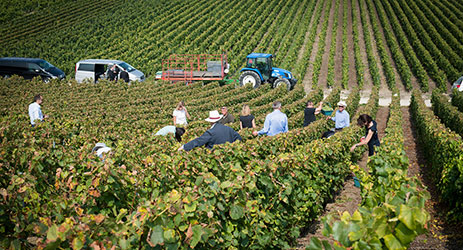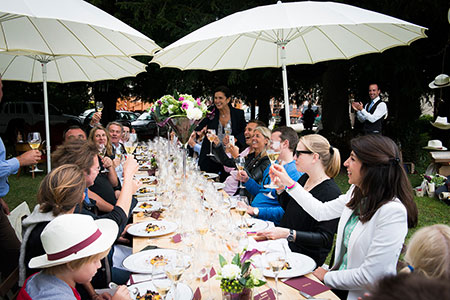Breakfast at Krug.
It could be the title of a Scott Fitzgerald novel, a Tamara de Lempicka painting, a Mario Testino photograph.
What it is instead is the way I spent one of the most perfect mornings of the year, out in the vines, helping to bring in a tiny proportion of grapes for the 2014 harvest at this most legendary of Champagne houses.

I wish I could say this every month, but Krug seems to have been a constant presence in recent weeks.
First of all, among the jumble of news that hurtles down the wires in the months following the summer break, a new health law is currently working its way through the Paris parliament.
Its contents have managed to, once again, get the 500,000 members of the French wine industry riled up. Not because of what it says, but because of what it doesn’t say; namely no clearer definition of what is and is not allowed when it comes to talking about wine.

As it stands today, in theory any mention of wine in print, radio or TV in France can be deemed to be illegal – and producers are so jumpy about it that Krug, a brand that should make its country glow with pride, has this month released a book Krug by Krug Loversin English only, because they are not allowed to publish it in French due to the terms of the country’s much-maligned Evin law that governs public mention of all alcohol. The book, expectedly glossy, contains images from the archives showcasing its history and its present, with contributions from Krugistes including Ernest Hemingway, Brigitte Bardot, Karl Largerfeld and Serge Gainsbourg, as well as an array of perfumers, chefs, artists and writers. The fact that it cannot be published in French is crazy.
Continuing the theme, a few days ago I interviewed Nicolas Audebert for Decanter magazine. He has joined Chanel-owned chateaux on both the Left and Right banks of Bordeaux – Rauzan-Ségla in Margaux and Canon in Saint Emilion. He arrives here from Cheval des Andes in Argentina, but cut his teeth with five years as winemaker for Krug’s Clos de Mesnil. When we talked about my harvest there, it turned out that he was the winemaker for the 2003 vintage that I had drunk at lunch after having been out in the vines.
Rauzan-Ségla and Canon must rightly be thrilled to have secured his services, because Krug (owned by another of France’s luxury goods houses, in this case LVMH since 1999, although a 150-year old company) is the epitome of how microscopic vision and softly softly patience is the key to wine royalty. It’s become an archetype of excellence, its Grande Cuvée composed, on average, of 150 base wines from around 13 different vintages, with well over a decade between the moment of bottling and that of disgorgement. The 2012 Grand Cuvée pushes this obsession even further; 198 wines from 12 different vintages, separated by 23 years. Like I said; softly, softly.
After the 250 different vineyard plots have been harvested (you’re welcome) the resulting still wine is aged in small-sized barrels of 205 litres. The blending committee will analyse, taste and note many times over each individual cuvée. Around 5,000 tasting notes allow the chef de cave to suggest three potential blends to the committee who must then – unanimously – decide which one takes the prize.
The Krug Method is relentless. In 2010 CEO Margareth Henriquez says they discarded 30,000 litres of wine already blended that didn’t live up to the quality they were looking for – and this decision was taken when the financial crisis had seen Krug revenues drop 30% between 2008 and 2009. LVMH responded by enlarging Krug’s blending reference cellar up to 350 wines, all identified by lot and year, stocked in small vats of 10hl.

The Grand Cuvée is legendary, but we – Margareth, chef de cave Eric Label, house director Olivier Krug and our small group of lucky pickers – are in Clos de Mesnil, a single vineyard in the pretty village of Le-Mesnil-sur-Oger in the Côte de Blancs that has become an icon of great champagne. Its vines are divided into five parcels that are each followed individually and depending on Lebel’s decision, the grapes will either make it into Krug’s reserve wines or into Clos de Mesnil. It has only belonged to the Krug family since 1971 and Olivier is telling us as we walk around the vines that they had ‘no clue at first’ just how lucky they were to have found it. ‘The grapes were used as part of the general blend for the first few years, but stood out in our tasting sessions every single time, and in 1979 we made it for the first time as a single wine – at first just for friends. It’s not an exaggeration to say that we treat it like a family garden, although harvest can still take anything from two to 10 days depending on the year. But taking our time to pick at the exact right moment is crucial, because our blending process begins right here, with tasting the grapes as they come off the vine.’
We spend several hours in the vineyards, with line sheriffs watching over us and relieving us of our baskets as they fill up with grapes. Then it’s back to Clos de Mesnil, where a long table is stretched out within touching distance of the vines and the dry-stone wall that surrounds the 1.84 hectare vineyard and dates back to 1698. The Clos de Mesnil 2003 is joined by the 1998, the Grande Cuvée (id 211021 is you’re wondering) and the 1985 Krug in magnum. The food is perfectly chosen – fresh fragrant crab, succulent duck, marinated vegetables with wonderfully sour pickles. The atmosphere managed to feel somewhere between a family wedding and a Downton Abbey picnic. The Champagnes are sublime, mingling pears, peaches, citrus fruit with a verticality that seems to draw your mouth up around 10 feet above the table. One of the biggest surprises is the rosé in magnum, paired with the smoky richness of the duck, which has been transformed in their hands to something rich, deep, fully-realised. Everything feels effortless and yet is clearly organised down to the tiniest aspect.
I am telling Nicolas Audbert about it as we take a walk through his own new vineyards at Chateau Canon, above the limestone bedrock of Saint Emilion. He shakes his head with a smile. ‘Krug taught me the most important lesson of all in wine. That details don’t just count. They are everything.’
Krug Clos de Mesnil 2003
Released in July of this year, the first vintage since 2000, and one of the smallest releases in the estate’s history with just 8,671 bottles and 659 magnums (yes, it really is that detailed). The beauty of Clos de Mesnil comes in its aromatic richness matched by a finesse that makes it feel as light as air. Subtle, precise and a masterclass in what can be achieved with confidence and time.

Columnist Introduction
Jane Anson is Bordeaux correspondent for Decanter, and has lived in the region since 2003. She is author of Bordeaux Legends, a history of the First Growth wines (October 2012 Editions de la Martiniere), the Bordeaux and Southwest France author of The Wine Opus and 1000 Great Wines That Won’t Cost A Fortune (both Dorling Kindersley, 2010 and 2011). Anson is contributing writer of the Michelin Green Guide to the Wine Regions of France (March 2010, Michelin Publications), and writes a monthly wine column for the South China Morning Post in Hong Kong, where she lived from 1994 to 1997. Accredited wine teacher at the Bordeaux Ecole du Vin, with a Masters in publishing from University College London.
Click here to read all articles by Jane Anson>>
- Follow us on Weibo @Decanter醇鉴 and Facebook
and Facebook for most recent news and updates -
for most recent news and updates -
All rights reserved by Future plc. No part of this publication may be reproduced, distributed or transmitted in any form or by any means without the prior written permission of Decanter.
Only Official Media Partners (see About us) of DecanterChina.com may republish part of the content from the site without prior permission under strict Terms & Conditions. Contact china@decanter.com to learn about how to become an Official Media Partner of DecanterChina.com.

Comments
Submit